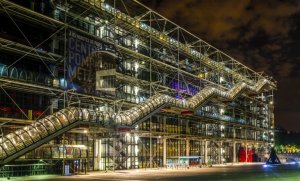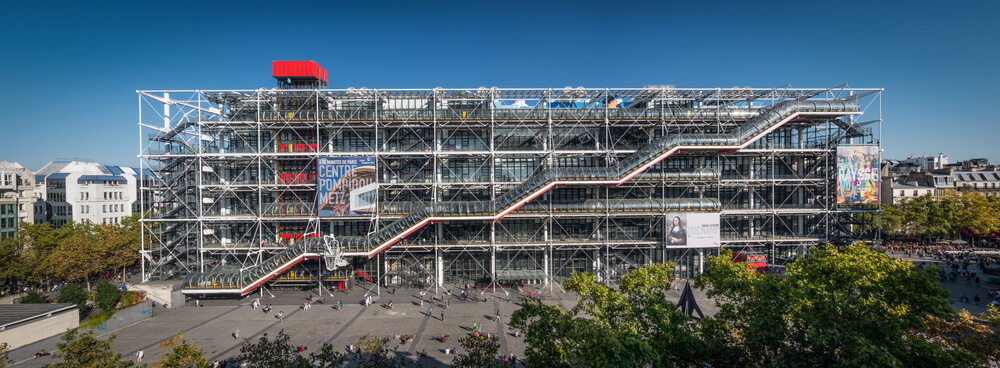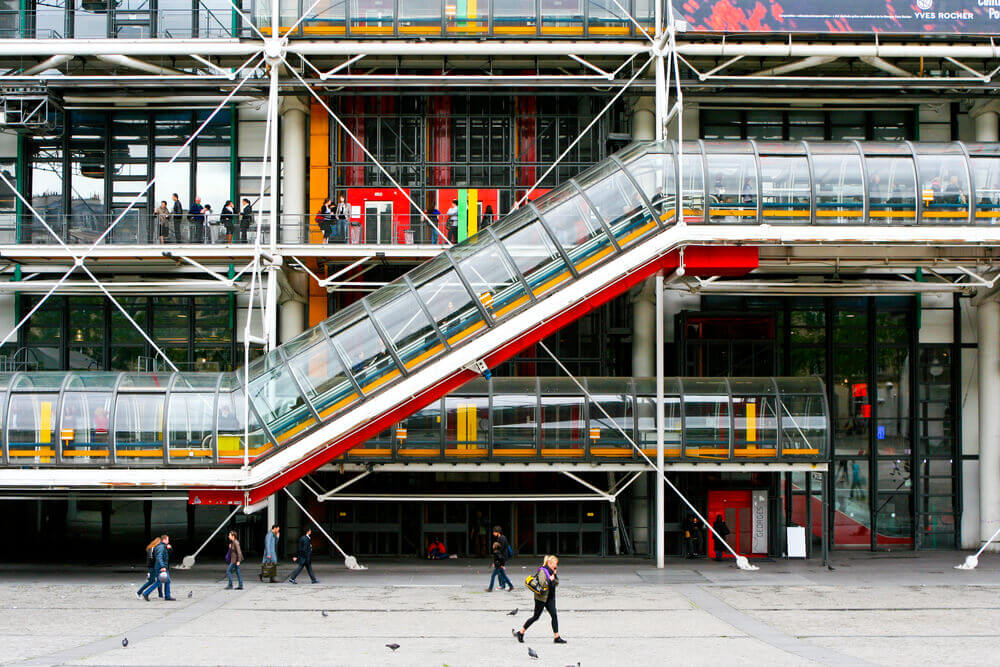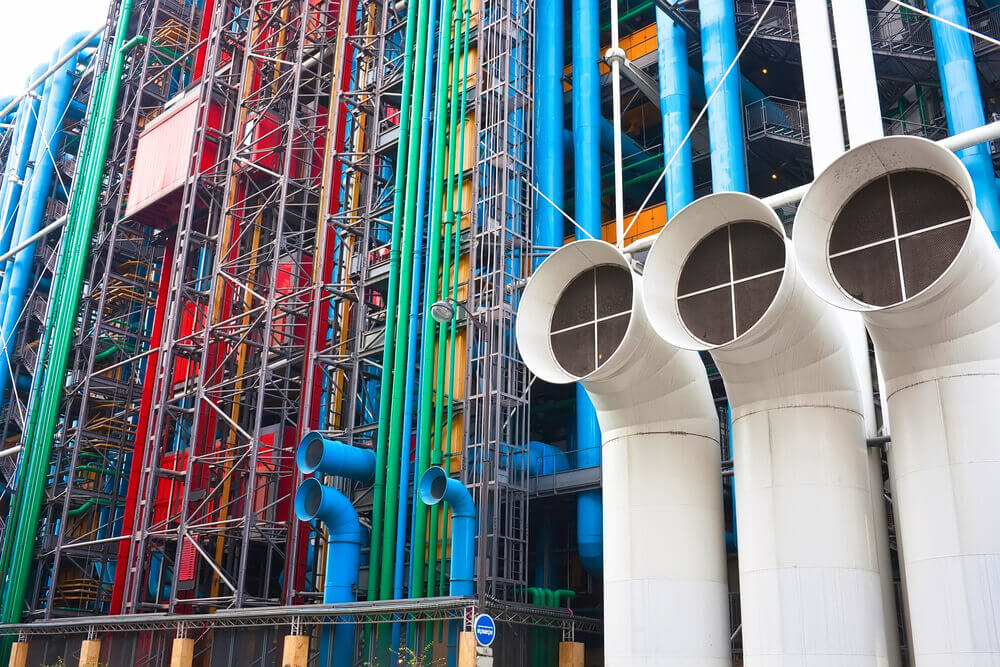The Architecture of the Pompidou Center

In this article, we’re going to discuss the aesthetic importance of the architecture of the Pompidou Center. Its external appearance offers a completely innovative and avant-garde look. This building breaks with all traditional dynamics.
Is it possible that we’ve seen the direct influence of technology on art and decoration since the 1970s? As times change, the way people work has also changed. So yes, technology has impacted almost all aspects of our lives.
Within the field of architecture, the progress of construction and new design approaches have led to the development of buildings that break with conservative procedures. In other words, new techniques have allowed architects to innovate and regenerate their art.
The history of Pompidou Center

The Pompidou Center was built in 1977 in Paris, France. Renzo Piano and Richard Rogers created the design of the building. They tried to create a futuristic architecture design that broke with the traditional styles of construction that architects used in Europe at the time.
Undoubtedly, modernist works from the early twentieth century, and iron infrastructures influenced the building’s look. The industrial revolution had a great influence on this century and art.
However, this center is an architectural utopia come to life. While some people thought the techniques weren’t possible at the time, the building has become emblematic. It’s something many architects look to and are inspired by.
A true work of art should try to take advantage of the space, encourage innovation, and open new directions for architecture.
The main aesthetic aspects of the Pompidou Center

This building stands out for being a large urban building. Also, it offers a curious appearance to passersby. The aesthetic is completely different from what we commonly know. Next, we’ll see the main characteristics of this building:
- The structure of the building consists of 10 levels. The main use of the building is space for art exhibitions. It also has two movie theaters, a showroom, a conference room, a public library, and a documentation and research center.
- Iron is the dominant material of this building. This material is also visible from the outside. The inner structure of this building can be seen from the outside. This building takes the idea of concealing supports and turns it on its head.
- The building plays with liberating space and creates large interior spaces. The outside features what looks like scaffolding on the facade. There’s no attempt to cover up any of the designs.
- The Center has a very industrial character. It represents a new take on a very industrial design. There’s no doubt that this is a new look for buildings of the time.
The structural function of color

In terms of colors, some appear to combine the silver hues of iron among a mass of color that surrounds the building. In this way, the building creates a very interesting, lively feeling.
However, the colors on the outside also have meaning:
- All the air ducts in the building are blue. These tubes appear to mimic the feeling of the blue sky.
- The water pipes are green. While not as brilliant as the blue, this color plays an important role in the facade.
- The electrical circuits are yellow. This helps to create contrast with the previously mentioned colors.
- Finally, red is perhaps the most relevant color. The painters used red for anything involving the transit of people. The warmth offered by this tone helps to avoid any coldness created by the iron.
The Pompidou Center is synonymous with art

The architecture of the Pompidou Center has been used to try to display all kinds of art. However, don’t forget that the building itself is a work of art!
In this article, we’re going to discuss the aesthetic importance of the architecture of the Pompidou Center. Its external appearance offers a completely innovative and avant-garde look. This building breaks with all traditional dynamics.
Is it possible that we’ve seen the direct influence of technology on art and decoration since the 1970s? As times change, the way people work has also changed. So yes, technology has impacted almost all aspects of our lives.
Within the field of architecture, the progress of construction and new design approaches have led to the development of buildings that break with conservative procedures. In other words, new techniques have allowed architects to innovate and regenerate their art.
The history of Pompidou Center

The Pompidou Center was built in 1977 in Paris, France. Renzo Piano and Richard Rogers created the design of the building. They tried to create a futuristic architecture design that broke with the traditional styles of construction that architects used in Europe at the time.
Undoubtedly, modernist works from the early twentieth century, and iron infrastructures influenced the building’s look. The industrial revolution had a great influence on this century and art.
However, this center is an architectural utopia come to life. While some people thought the techniques weren’t possible at the time, the building has become emblematic. It’s something many architects look to and are inspired by.
A true work of art should try to take advantage of the space, encourage innovation, and open new directions for architecture.
The main aesthetic aspects of the Pompidou Center

This building stands out for being a large urban building. Also, it offers a curious appearance to passersby. The aesthetic is completely different from what we commonly know. Next, we’ll see the main characteristics of this building:
- The structure of the building consists of 10 levels. The main use of the building is space for art exhibitions. It also has two movie theaters, a showroom, a conference room, a public library, and a documentation and research center.
- Iron is the dominant material of this building. This material is also visible from the outside. The inner structure of this building can be seen from the outside. This building takes the idea of concealing supports and turns it on its head.
- The building plays with liberating space and creates large interior spaces. The outside features what looks like scaffolding on the facade. There’s no attempt to cover up any of the designs.
- The Center has a very industrial character. It represents a new take on a very industrial design. There’s no doubt that this is a new look for buildings of the time.
The structural function of color

In terms of colors, some appear to combine the silver hues of iron among a mass of color that surrounds the building. In this way, the building creates a very interesting, lively feeling.
However, the colors on the outside also have meaning:
- All the air ducts in the building are blue. These tubes appear to mimic the feeling of the blue sky.
- The water pipes are green. While not as brilliant as the blue, this color plays an important role in the facade.
- The electrical circuits are yellow. This helps to create contrast with the previously mentioned colors.
- Finally, red is perhaps the most relevant color. The painters used red for anything involving the transit of people. The warmth offered by this tone helps to avoid any coldness created by the iron.
The Pompidou Center is synonymous with art

The architecture of the Pompidou Center has been used to try to display all kinds of art. However, don’t forget that the building itself is a work of art!
All cited sources were thoroughly reviewed by our team to ensure their quality, reliability, currency, and validity. The bibliography of this article was considered reliable and of academic or scientific accuracy.
- Dal Co, Francesco: Centre Pompidou, Milán, Electa, 2014.







